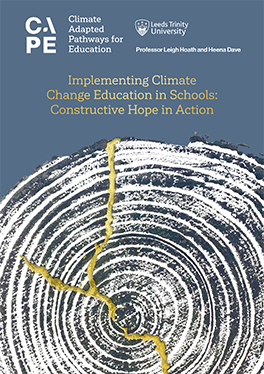Sashiko Thread: An Artist's Journey to Constructive Hope
Lyndsey Miles
Artist
When I was asked to create the original artwork for the CAPE report, “Implementing Climate Change Education in Schools: Constructive Hope in Action”, I felt honoured and excited, but nervous too.
CAPE’s thoughtful approach is evidence informed and its co-founders are dedicated and emotionally invested in making sure that climate change education must be long term, impactful and rooted in educational expertise. It’s what separates CAPE from anything I’ve seen before. CAPE rejects fleeting or superficial responses to complex issues; it achieves its mission through deep relationships with school leaders. I wanted my artwork to honour their vision and commitment. It was a big responsibility.
We had discussed the beautiful Tide Lines lyrics and the artwork on their new album cover, An Ocean Full of Islands, at length. I thought it resembled Sashiko embroidery. Sashiko (or “little stitches”) being an ancient (Edo period) Japanese sewing craft used to stitch several layers of clothing together (to trap air) and a beautiful way to celebrate the repair and preserving of clothing and reminiscent of Kintsugi.
During 2020, after a breast cancer diagnosis, I found hope in the form of a dragon boat team. I joined Oxford Paddlers For Life, a charity that provides facilities and training in dragon boating for people who have been affected by cancer to support their physical and mental health. Sashiko (their smaller boat) has inspired my artwork and a trip to see the collection of work at SOAS Brunei Gallery’s ‘Japanese Aesthetics of Recycling’ show last year fed a craving to learn more. Kintsugi (the larger team boat), is named after the Japanese art of repairing broken pottery with gold to show that breakage and repair is part of an object’s history and something to embrace rather than disguise.
My first paddle in Kintsugi was an emotional experience. I felt overwhelmed with gratitude for my family, the NHS, and everyone that had supported me in my recovery. As the team pulled each stroke, I felt more empowered. I was proud of myself. My son paddled with me. I felt like cancer was a million miles away from my life. My daughter and husband watched from the bank. I was so overcome with joy and pride at what we had done - what we’d endured - how far we’d come - our little family team. The Oxford Paddlers and Kintsugi played a huge part in helping me overcome the darkest of days and gave me hope for the future.
When I first heard the word cancer, I thought my life was over, but it had actually only just begun. I have since allowed myself time to create and learn more about art. The value of time has become critical to my practice as an artist. I have always loved the outdoors and being active. I worked around my treatment and explored as much as possible. I would research and plan circular mountain walks during the week of my chemotherapy, and the following week (when I felt at my worst physically) I would read adventure books and message friends with all sorts of future endeavours. In my third week (when I felt at my fittest), I would get out in the mountains and nature - I felt safe and secure there.
Our environment, the world around us, the relationships we form in and between all things human and non-human manifest in my artwork. I wanted these meanings, narratives and hope to be part of the art I created for CAPE’s report.
The German artist, Paul Klee said, “Art does not reproduce the visible, it makes visible.” Art can and does make us see things in a different way. I wanted to make the observer question what and how they see by creating and investigating various techniques with new forms of representation and their expressive possibilities. Artistically, I wanted to push materials to stress points and trauma and consider how our environment and sense of self leads to and becomes fragments of that trauma.
Part of the process in making the prints, depicted on the front cover of the report, meant burning the surface of decayed logs to reveal the rings - representing growth. The age of the decayed logs caused cracks to appear. I saw this as representing our age of the Anthropocene (the period during which human activity has been the dominant influence on climate and the environment). The gold signified constructive hope, mending the damage. Just like our boat Kintsugi had helped to repair my hope, the work of CAPE has and does bring constructive hope for climate change education.
There are times when I’ve questioned making art at all. It’s carbon footprint; it’s impact on our environment with not only galleries but transport, packaging, materials, and lavish openings all contributing to the production of an artwork. Through my work with CAPE, I have been inspired to look further into more sustainable regenerative materials, crafts, and processes. manifesting relationships with the matter and therefore the environment they come from (Weintraub, 2012). As Weintraub suggests, factoring in these considerations does not “constitute an impoverishment of creative opportunities” - in fact, quite the opposite!
CAPE’s sole mission is to improve the quality of climate change education for all children and young people and bring hope. It is more than that which each individual who contributes will ever get out of it - it’s bigger than us - it’s bigger than the sum of its parts. I am in admiration of its mission and await with anticipation for what is to come.
Through art, I am reminded that Sashiko threads are twisted together, creating one single strand - much like the branches of CAPE. A single strengthened strand of hope.

